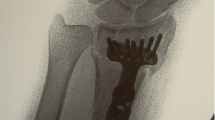Abstract
Purpose
This retrospective study was to compare the clinical outcomes of volar locking plating (VLP) and percutaneous Kirschner wiring (PKW) for the management of displaced Colles type distal radius fractures in patients between 50 and 70 years old.
Methods
There were 31 elderly patients with displaced Colles’ fractures treated by VLP. We compared them to 31 match-paired patients treated by PKW. The patients were matched according to age (within five years) and sex. All patients were followed up retrospectively for at least 12 months. The functional outcomes and radiological results were compared between the two groups.
Results
All fractures healed within three months. There were two complications (6.5%) in the PKW group and one complication (3.2%) in the VLP group. At final follow-up, wrist flexion, extension, and ulnar deviation were significantly better in the VLP group compared with the PKW group (all p values<0.05). According to modified Green and O’Brien criteria, the VLP group showed a trend towards increased rate of satisfactory outcome compared with the PKW group (p = 0.09).
Conclusion
For the treatment of displaced Colles’ fractures in patients between 50 and 70 years old, both groups had high union rate and low complication rate. However, better functional results can be expected in association with open reduction and volar locking plating.


Similar content being viewed by others
References
Arora R, Gabl M, Gschwentner M, Deml C, Krappinger D, Lutz M (2009) A comparative study of clinical and radiologic outcomes of unstable Colles type distal radius fractures in patients older than 70 years: nonoperative treatment versus volar locking plating. J Orthop Trauma 23(4):237–242
Barton T, Chambers C, Bannister G (2007) A comparison between subjective outcome score and moderate radial shortening following a fractured distal radius in patients of mean age 69years. J Hand Surg Br 32:165–169
Chou YC, Chen AC, Chen CY, Hsu YH, Wu CC (2011) Dorsal and volar 2.4-mm titanium locking plate fixation for AO type C3 dorsally comminuted distal radius fractures. J Hand Surg Am 36(6):974–981
Diass JJ, Wray CC, Jones JM, Gregg PJ (1987) The value of early mobilization in the treatment of Colles’ fractures. J Bone Joint Surg Br 69:727–729
Gereli A, Nalbantoğlu U, Kocaoğlu B, Türkmen M (2010) Comparison of palmar locking plate and K-wire augmented external fixation for intra-articular and comminuted distal radius fractures. Acta Orthop Traumatol Turc 44(3):212–219
Green DP, O’Brien ET (1978) Open reduction of carpal dislocations: indications and operative techniques. J Hand Surg Am 3:250–265
Herron M, Faraj A, Craigen MA (2005) Dorsal plating for displaced intraarticular fractures of the distal radius. Injury 36:236
Hollevoet N, Vanhoutie T, Vanhove W, Verdonk R (2011) Percutaneous K-wire fixation versus palmar plating with locking screws for Colles' fractures. Acta Orthop Belg 77(2):180–187
Huard S, Blanchet N, Leclerc G et al (2010) Fractures of the distal radius in patients over 70 years old: Volar plates or K-wires? Chir Main 29(4):236–241
Hull P, Baraza N, Gohil M et al (2011) Volar locking plates versus K-wire fixation of dorsally displaced distal radius fractures—a functional outcome study. J Trauma 70(6):E125–E128
Keating JF, Court-Brown CM, McQueen MM (1994) Internal fixation of volar-displaced distal radial fractures. J Bone Joint Surg Br 76:401–405
Khamaisy S, Weil YA, Safran O, Liebergall M, Mosheiff R, Khoury A (2011) Outcome of dorsally comminuted versus intact distal radial fracture fixed with volar locking plates. Injury 42(4):393–396
Kwan K, Lau TW, Leung F (2011) Operative treatment of distal radial fractures with locking plate system-a prospective study. Int Orthop 35(3):389–394
Lattmann T, Meier C, Dietrich M, Forberger J, Platz A (2010) Results of volar locking plate osteosynthesis for distal radial fractures. J Trauma 70(6):1510–1518
Marcheix PS, Dotzis A, Benkö PE, Siegler J, Arnaud JP, Charissoux JL (2010) Extension fractures of the distal radius in patients older than 50: a prospective randomized study comparing fixation using mixed pins or a palmar fixed-angle plate. J Hand Surg Eur 35(8):646–651
McFadyen I, Field J, McCann P, Ward J, Nicol S, Curwen C (2011) Should unstable extra-articular distal radial fractures be treated with fixed-angle volar-locked plates or percutaneous Kirschner wires? A prospective randomised controlled trial. Injury 42(2):162–166
Nana AD, Joshi A, Lichtman DM (2005) Plating of the distal radius. J Am Acad Orthop Surg 13:159–171
Sommer C, Brendebach L, Meier R, Leutenegger A (2001) Distal radius fractures—retrospective quality control after conservative and operative therapy. Swiss Surg 7:68–75
Stevenson I, Carnegie CA, Christie EM, Kumar K, Johnstone AJ (2009) Displaced distal radial fractures treated using volar locking plates: maintenance of normal anatomy. J Trauma 67(3):612–616
Tsukazaki T, Takagi K, Iwasaki K (1993) Poor correlation between functional results and radiographic findings in Colles’ fracture. J Hand Surg Br 18:588–591
Voigt C, Lill H (2006) What advantages does volar plate fixation have over K-wire fixation for distal radius extension fractures in the elderly? Unfallchirurg 109(10):848–854
Yasuda M, Ando Y (2009) A new variable angled locking volar plate system for Colles' fracture: outcome study and time-course improvement of objective clinical variables. Hand Surg 14(2–3):93–98
Author information
Authors and Affiliations
Corresponding author
Rights and permissions
About this article
Cite this article
Lee, YS., Wei, TY., Cheng, YC. et al. A comparative study of Colles’ fractures in patients between fifty and seventy years of age: percutaneous K-wiring versus volar locking plating. International Orthopaedics (SICOT) 36, 789–794 (2012). https://doi.org/10.1007/s00264-011-1424-2
Received:
Accepted:
Published:
Issue Date:
DOI: https://doi.org/10.1007/s00264-011-1424-2




